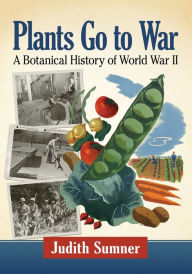Download books on kindle for ipad Plants Go to War: A Botanical History of World War II
Par sandoval ruth le samedi, janvier 11 2020, 07:03 - Lien permanent
Plants Go to War: A Botanical History of World War II. Judith Sumner

Plants-Go-to-War-A.pdf
ISBN: 9781476676128 | 366 pages | 10 Mb

- Plants Go to War: A Botanical History of World War II
- Judith Sumner
- Page: 366
- Format: pdf, ePub, fb2, mobi
- ISBN: 9781476676128
- Publisher: McFarland & Company, Incorporated Publishers
Download books on kindle for ipad Plants Go to War: A Botanical History of World War II
As the first botanical history of World War II, Plants Go to War examines military history from the perspective of plant science. From victory gardens to drugs, timber, rubber, and fibers, plants supplied materials with key roles in victory. Vegetables provided the wartime diet both in North America and Europe, where vitamin-rich carrots, cabbages, and potatoes nourished millions. Chicle and cacao provided the chewing gum and chocolate bars in military rations. In England and Germany, herbs replaced pharmaceutical drugs; feverbark was in demand to treat malaria, and penicillin culture used a growth medium made from corn. Rubber was needed for gas masks and barrage balloons, while cotton and hemp provided clothing, canvas, and rope. Timber was used to manufacture Mosquito bombers, and wood gasification and coal replaced petroleum in European vehicles. Lebensraum, the Nazi desire for agricultural land, drove Germans eastward; troops weaponized conifers with shell bursts that caused splintering. Ironically, the Nazis condemned non-native plants, but adopted useful Asian soybeans and Mediterranean herbs. Jungle warfare and camouflage required botanical knowledge, and survival manuals detailed edible plants on Pacific islands. Botanical gardens relocated valuable specimens to safe areas, and while remote locations provided opportunities for field botany, Trees surviving in Hiroshima and Nagasaki live as a symbol of rebirth after vast destruction.
The Willow Run Bomber Plant: Save a Piece of History | Save The
The historic Willow Run plant produced B-24 bombers at the staggering rate of one per We're Saving a Piece of History – Let's Keep the Progress Going! And in the race to win World War II, minority groups that were previously excluded
Plants Go To War - A Botanical History Of World War II - Saraiva
As the first botanical history of World War II, Plants Go to War examines military history from the perspective of plant science. From victory gardens to drugs,
Plants Go to War: A Botanical History of World War II | NHBS
As first botanical history of World War II, Plants Go to War examines military history from the perspective of plant science. From victory gardens to drugs, timber,
Plants Go to War: A Botanical History of World War II: Amazon.de
As the first botanical history of World War II, Plants Go to War examines military history from the perspective of plant science. From victory gardens to drugs,
Canola oil - Wikipedia
Canola oil, or canola for short, is a vegetable oil derived from a variety of rapeseed that is low in erucic acid, as opposed to colza oil. There are both edible and industrial forms produced from the seed of any of several cultivars of the plant family Brassicaceae, namely cultivars of Brassica napus World War II caused high demand for the oil as a lubricant for the rapidly
History of Toyota - Wikipedia
After World War II, Japan experienced extreme economic difficulty. produced only 300 trucks and was on the verge of going out of business. One example was the construction of the Motomachi Plant in 1959, which
Extracts from the history and medical properties of garlic - NCBI
Liliaceae) is a widely distributed plant. Garlic expansion probably occurred in the old world first, and later in the new world. . in America during 1917 and 1918, people wore a necklace of garlic when going out in public.[9] soldiers during World War I.[5] Although penicillin was already used in World War II, the Russian